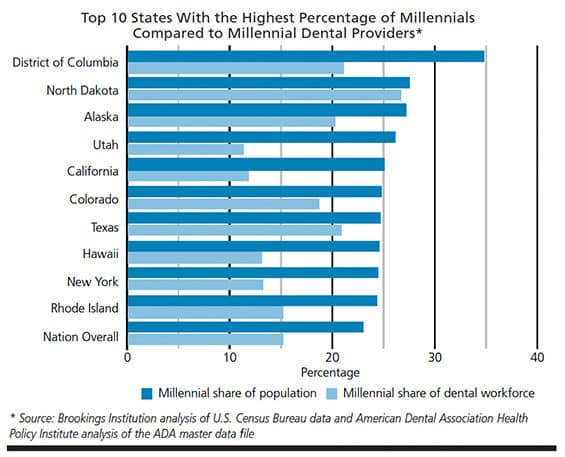Young Dentists Are Reshaping the Workforce
As more dental practitioners delay retirement beyond age 65, the average age of dentists is going up nationally.
As more dental practitioners delay retirement beyond age 65, the average age of dentists is going up nationally. While the median age at which primary care physicians retire in the United States is 64.9 years,1 the average age for dentists is 68.8 years.2 This graying of the dental workforce is being offset, however, by the influx of millennials into the profession.
Generally defined as those born between 1981 and 1997, millennials are now the largest living generation in the United States.3 However, millennial dentists are not evenly distributed across the country. In some states, one in four dentists is under the age of 35, while in other states, only one in nine is younger than 35.4
According to American Dental Association Health Policy Institute data, the five states with the highest percentages of young dentists are North Dakota (26.7%), Nebraska (26%), New Mexico (25.5%), Massachusetts (23.8%) and Nevada (23.2%).4 What is interesting is that among these states, only North Dakota appears on the national list of states with the highest percentage of millennials. Indeed, some states with the highest percentage of millennials have the lowest percentage of millennial dentists. For example, Utah has the fourth largest millennial population by percentage (26.1%), but the lowest percentage of millennial dentists in the country (11.4%). In addition, California has the fifth highest share of millennials by percentage (25%), but is second to last in the percentage of dentists under 35 (11.8%).
The disparity may be due to mobility in the young dental workforce. As they graduate dental school, millennial providers could be moving to areas where the percentage of middle aged and older adults is higher. After all, the need for dental care tends to increase with age, possibly creating more work in these states for young dentists. However, other factors may also be influencing the distribution of younger dentists across the country. One thing is certain: For areas interested in ensuring adequate access to dentists in the future, knowing why some states attract more younger clinicians could help reverse the graying of the profession.
REFERENCES
- Petterson SM, Rayburn WF, Liaw WR. When do primary care physicians retire? Implications for workforce projections. Ann Fam Med. 2016;14:344–349.
- American Dental Association Health Policy Institute. The Dentist Workforce — Key Facts Available at: ada.org/~/media/ADA/Science%20and%20Research/HPI/Files/HPIgraphic_0716_1.pdf. Accessed January 17, 2019.
- Frey WH. The millennial generation: A demographic bridge to America’s diverse future. Available at: brookings.edu/events/the-millennial-generation-a-demographic-bridge-to-americas-diverse-future/. Accessed January 17. 2019.
- American Dental Association Health Policy Institute analysis of ADA master file.
From Decisions in Dentistry. February 2019;5(2):46.


